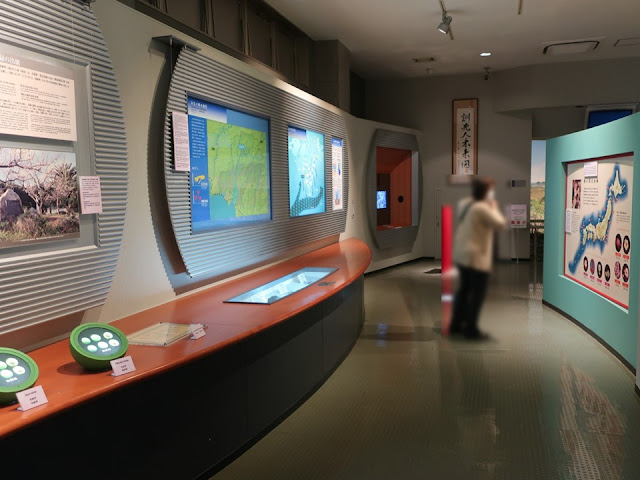Minabe town is in Wakayama prefecture of western Japan. Wakayama produces around 60% of ume which is Japanese plum. Minabe town is the center of ume production. One third of farmers produce ume and there is a ume section in Minabe town office, which was set up in 1973. Towners grow ume, manufacture ume products, and love ume.
梅の生産量の約六割を占めるという和歌山県、その中心地のみなべ町。農家の1/3が梅農家で、1973年には、役所に「うめ課」ができました。梅作り、梅干などの製造、梅への愛が溢れています。
The museum (lower left) is surrounded by ume trees. There is a history and folklore exhibition room in the first floor, there is a ume exhibition room in the 2nd floor, and there is a roadside station at the third floor in which we can rest and can buy specialties. There are many ume related factories along the road (route 424) which products pickled dried ume, ume vinegar, ume liquor and so on.
梅林に囲まれた建物で、資料館(1階は歴史資料展示、2階はうめ資料展示)、及び道の駅(3階)です。道沿い(国道424号)には梅干し、梅酢、梅酒など梅酒関連の工場がたくさんあります。
Japanese people like to eat ume with rice. Ume is mainly eaten as pickled dried ume (ume-boshi).
日本人は、ご飯と梅干が大好きです。
Ume exhibition roomうめ資料展示室
There are models of a bush warbler and a blossoming tree at the entrance. It is written, “The bush warbler telling coming of spring as a symbol of town warmly welcome people who visiting Minabe-town the best ume town in Japan.”
うぐいすはみなべ町のシンボル。来館者を迎えてくれます。
Nanko-Ume which is a local variety, the climate and so on are explained. The original tree of Nanko-Ume was discovered in 1902; it’s not so long-time ago. The tree had more and bigger fruits than others.
南高梅、その栽培に適したみなべの気候などが紹介されています。梅の栽培は古くから行われていましたが、南高梅が発見されたのは明治35(1902)年。意外と新しいです。豊産で粒が大きい優良種だったそうです。
The scenery of Minabe plum-grove is introduced by the video. Although it was under repairing when I visited, I could imagine the scent and the beauty. It is written in Japanese that we can see a million of ume trees from here and the scent can reach a thousand mile. It’s a nice saying.
みなべの梅林風景。折悪く、映像は見られませんでした。でも、梅の香と美しさは伝わります。「一目百万、香り千里」と言うそうです。いい言葉ですね。
We can learn various things about ume. There are many ume producing areas in Japan, but 57,500 tons of ume was produced in Wakayama prefecture including Minabe in 2019. 1,600 tons was produced in Mie prefecture which was the second producer. So, Wakayama is an overwhelming majority producer. After discovering Nanko-Ume around a hundred years ago, the production increased dramatically. It’s amazing! (The panel is written in Japanese, English and Chinese. One-line Korean sentence is added.)
梅について様々なことが学べます。たくさんの梅の産地がありますが、みなべを中心とする和歌山県の梅の生産量は、57,500t(2019年)。二位は三重県で1,600tなので、圧倒的に多いです。南高梅の発見後、わずか100年余りでこんなに生産が増えるのですから、驚きです。
The section is about the distribution and the consumption. Old pickled dried ume (ume-boshi) are exhibited. The Japanese oldest one which soaked in a medicinal herb was made before 16th century (lower right). Are you bold enough to eat it?
In the internal war time (16th century), samurai warriors carried processed ume with them; rice powder and sugar were added to ume-boshi. It was a portable food, which was good for thirsty and disinfection of raw water.
梅の流通や消費のコーナー。古い梅干しが展示されていますが、口にするのは勇気がいりそうです。右下は、日本最古の薬草漬梅干しです。江戸時代の梅干しも展示されています。
戦国時代には、梅干しと米粉を砂糖で練り固めた「梅干丸(うめぼしがん)」が武士の携帯食でした。喉の渇きを癒やすだけでなく、生水の殺菌効果もありました。
People utilize the slope of mountains very well. They have coppice forest at high area, which supplies the material of charcoal and prevents slope from collapsing; the charcoal is their specialty “Kishu-binchotan”. The plum-groves are under the coppice forest. The ume fruits are processed in lowland. I guess someone led the project. It was designated as Globally Important Agricultural Heritage System “Minabe-Tanabe Ume System” by FAO in 2015.
梅作りはみなべの斜面を上手く利用した産業です。高いところは紀州備長炭用の林にして崩落を防ぎ、その下に梅林。そして里地では梅の加工。誰かのリーダーシップと人々の協力あっての「みなべ・田辺の梅システム」(世界農業遺産)だと思います。
Many people have a ume tree in their garden, because it bears fruits. We can learn everything about ume such as biology, nutrition, literature. The photo above are labels of sake (alcohol) bottles which names include “ume”. Ume is familiar to Japanese.
梅は実が採れて実用的なので、一般の家でも植えているところが少なくないです。梅の生態、栄養、文学、酒のラベルまで、梅のことは何でも分かります。
History and folklore exhibition room、歴史民俗展示室
History and folklore of Minabe are elaborately explained. I will highlight the fun of Japanese and ume here.
みなべの歴史、民俗がとても丁寧に説明されています。その中から、人々の楽しみと梅についての展示を紹介します。
Historical items are displayed by the wall, and folklore ones are exhibited in center.
壁際に歴史の展示、中央に民俗の展示が置かれています。
On the left side, people who contributed to Minabe are exhibited. They were farmers or teachers. The ordinary people developed ume business of Minabe.
左へ進むと南高梅の育成やみなべの梅産業の発展に貢献した人々が展示されています。みなべにとって大切な人たちですね。農民と園芸科の先生、身近な先輩たちです。
In the Edo period (1603~1868), ume-boshi were shipped to Edo (old name of Tokyo). Edo people put ume-boshi in tea and drank; it was called huku(happy)-cha(tea). They drank it in the evening of the New Year Eve. Ume-boshi was also the major ingredient of New Year's dishes in Edo.
遡って江戸時代、梅干の需要(福茶、喰い積み)が増した江戸へ梅を運びました。福茶は梅干しに熱湯を注いだもので、大晦日や節分の夜に飲みました。また、喰い積みは黒豆と梅干しを使った江戸時代のおせち料理でした。なお、当時のみなべは紀州徳川家の家臣・安藤家の紀伊田辺藩の所領でした。
The model above is a distribution center of the specialty charcoal “Bincyotan” in the Edo period.
The charcoal is popular because of burning for a long time. It was an important product of the local government. It was manufactured in mountainous area, and shipped from Minabe port. The carriers brought rice when they returned. Selling charcoal and bringing them were crucial income for people in mountainous area.
上の模型は、南紀の特産品・備長炭の集荷場です。
火持ちのよい備長炭は江戸時代から人気でした。藩の重要な輸出品になっていました。山中で作られた炭は、南部港から出荷されていきました。土地の痩せた山中の人々にとって、馬での輸送(駄賃馬)は大切な収入源になりました。米を積んで山中へ戻ります。
Minabe is on the pilgrimage route to Kumano shrines. Many nobles went through Minabe, and required locals to help carrying and suppling materials. It is written that it was a burden for locals (farmers). However, I guess it was a fun of locals because they enjoyed the procession of nobles; it was a kind of entertainments.
Reference article(参考記事):Kumano Nachi Taisha (shrine)、熊野那智大社
みなべは熊野詣の道中でもあります。平安中期からの皇族の熊野詣ででは、村人は物資の提供や運搬にかり出されました。「農民の負担になった」と書かれていますが、貴族の行列は人々の見物農民も農民も楽しませてもらったと思います。
It is a procession of the festival of Suga shrine. It is said that Emperor Ichijou (986-1011) ordered to establish the shrine. It is held to repose vengeful ghosts.
須賀神社の御霊祭の行列です。須賀神社は一条天皇(986-1011)の命を受け、京都の祇園御霊宮から勧請されたといわれています。御霊祭りは、怨霊を鎮める祭りです。
Local festivals are exhibited. I was impressed by the mountain festival. People welcome the mountain deity on the 7th of November which is the starting day of the mountain work. They offer sake and sanma fish (pacific saury). It is written that they pray for the safety and spend a sincere day. It is crucial to feel that we can live under the nature and we thank to it.
旧村の祭りが紹介されています。毎年11月7日、山の神(犬神さん)を迎える山祭りが印象的です。山仕事をする人たちが、さんまと酒を供え、直会をします。「明日からの山仕事が無事に出来るよう願い、人々は敬虔な一日を過ごします」と書かれています。自然の中で、生かされているという有難味を感じることが大切だと思います。
There is a section of ume art and craft. The photo above is a kimono dyed by ume.
梅に関する美術品、工芸品の展示コーナーです。梅の木の煮汁で作った梅染めの着物です。
We can see factories of ume related products. The photo above is the factory of Nakata Food which is the largest manufacture of ume-boshi. It is the key industry of Minabe.
みなべでは、梅干工場も見学できます。こちらは、最大手の中田食品さん本社工場の「梅回廊」。梅は基幹産業ですね。素晴らしいです。
Official
website: http://www.town.minabe.lg.jp/docs/2013091100182/
(in Japanese), accessed in November, 2023
Visited in
March, 2023
Previous post (particular landscapes in the same prefecture): Nanki
Kumano Geopark、南紀熊野ジオパーク
Next post (museum
in the same prefecture, the building is an ex-public bathhouse):Jin-Buro Museum、湯浅町と甚風呂(銭湯跡歴史資料館)



















Comments
Post a Comment